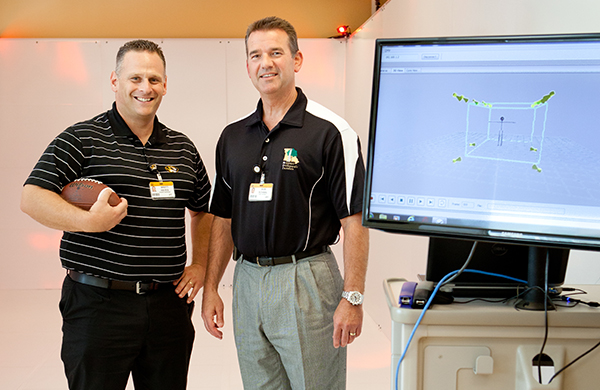
Brett Hayes’ tennis shoes squeak beneath him as he walks into a room within a room, a corridor created by three walls of reflective white plastic. Finding his way to the center of the space, Hayes resets and crouches with a football held out in front of him, taking the position of a quarterback under center, 14 unblinking infrared eyes looking back at him. After a sharp “hut!” he takes three quick steps back before planting and throwing the football to a waiting assistant. On a screen to the side, a 3-D stick figure moves with him in real time, a mirror image of the man in the machine.
The precise motion capture shown on the screen is a product of the DARI motion-capture system, which was unveiled at the Missouri Orthopaedic Institute in May. This system, the only one of its kind in world in clinical use, is used by Hayes and other physical therapists at the institute to gather data on a patient’s joint tension, torque and flexion and provides precise measurements down to one-tenth of a degree. Using the system, which tracks motion with infrared cameras, therapists can even identify if a patient is at risk for a ligament tear. The system also helps reveal how joints interact, which allows therapists to see if a patient is compensating for a knee problem by using his or her hips or back, for example.
“Every restrictive joint in the body has an effect on another joint in the body,” Hayes says. “So we want to make sure we get those things discovered on any patients so we can keep them from coming back for other problems.”
One of the most obvious uses of the motion-capture system is for sports medicine, though it has usages in other fields as well. Some University of Missouri athletes, including star forward Laurence Bowers, have already been tested in the machine, and the institute plans to gather baseline data on all MU athletes to help with any future treatment. The biggest benefits of the new technology, however, are its wide applications and how it takes the guesswork out of diagnoses and rehab.
Exceeding expectations
The high-tech DARI system is just one of the many rehabilitative and diagnostic tools used to treat patients at the Missouri Orthopaedic Institute. The institute, which celebrated its third anniversary in June, is the region’s most comprehensive orthopaedic surgery center, housing facilities for surgery, inpatient recovery, rehabilitation services and a full-service pharmacy in a single building at the corner of Stadium Boulevard and Virginia Avenue. This approach makes the institute a one-stop shop for patients and care more efficient for patients and doctors alike. This unique approach has led to unique success, as the center has surpassed its financial projections every year since opening.
Since it opened in the summer of 2010, the MOI has experienced consistent growth, both in volume of patients served and on its staff. ”We’ve shown incredibly steady growth over the last few years in terms of clinic patients, surgical patients and rehab patients,” says Bob Schaal, the executive director of the center. On June 3, the institute saw a new record high number of clinic patients.
The building itself has also seen expansions to help serve the institute’s growing clientele. Since opening, the center has added two operating rooms and four inpatient rooms to the five operating rooms and 16 inpatient rooms it opened with. “We’ve built out as much space as we can within the building,” says James Stannard, chair of orthopaedic surgery at MU. Initially, the MOI was only open five and half days a week, but it has since switched to being open 24/7/365 to accommodate the higher patient volumes.
In addition to treating patients, the orthopedic institute conducts advanced research, including cartilage research that could, much farther down the line, lead to joint replacements made from bone and cartilage grown in a lab rather than the metal and plastic ones used currently. Organic joint replacements would be able to heal themselves naturally without wearing down like the plastic and metal varieties.
With its notable care model and recent successes, the institute has become a paradigm for others trying to create similar medical facilities. “More and more people have approached us and asked to come look here because it has been such a successful model,” Stannard says.
Preparing for the future
Despite the huge strides the institute has made during the past few years, it refuses to rest on it successes. Actually, one of the biggest questions for the institute moving forward involves finding ways to keep its growth from hitting a plateau. To this end, a new building expansion that would add another wing to the center has been planned. The new wing, due for construction by 2017, will expand the MOI by as much as two-thirds of its present size and provide much needed clinical space and a second waiting area.
Another challenge facing the whole health care industry, MOI included, is the reduction in government funding to Medicare and other programs following the federal government’s sequestration in March. ”We really need to keep our eyes on the ball and figure out ways to be more and more efficient so that we can make it what’s becoming an increasingly austere environment.” Stannard says. “Thus far, we’ve been able to do that.”







